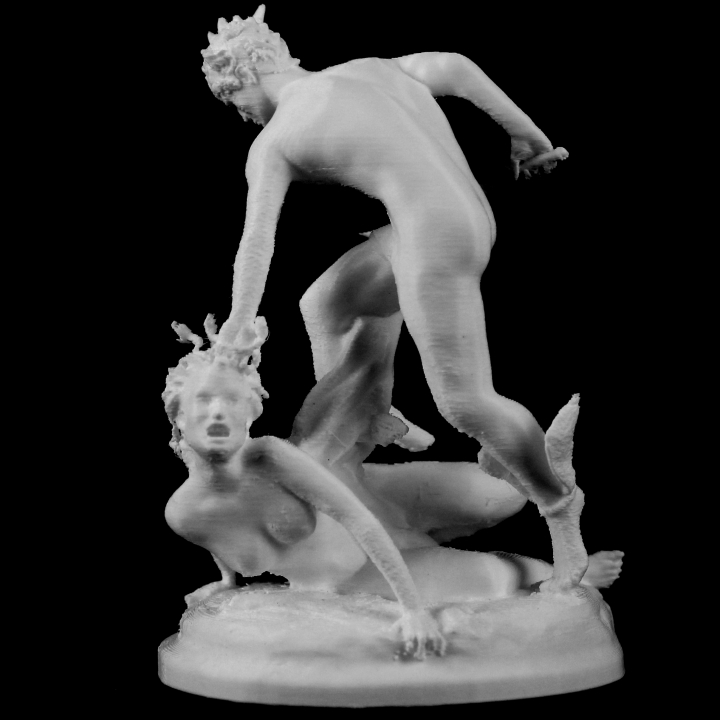
Perseus and the Gorgon
myminifactory
This larger-than-life marble sculpture showcases Perseus and Medusa in a dramatic moment of their legendary confrontation; it was created by Laurent Honoré Marqueste between 1875 and 1903 and is now permanently displayed at the Glyptothek in Copenhagen. The sculpture depicts the exact instant when Perseus beheads the fearsome Gorgon Medusa; When Perseus had grown up, Polydectes became infatuated with Danaë's beauty, but Perseus suspected that he was not a man of honor and protected his mother from him; then Polydectes plotted to send Perseus away in disgrace. He organized a grand banquet where each guest was expected to bring a gift. Polydectes requested that the guests contribute horses, under the pretense that he was collecting donations for Hippodamia's hand in marriage, who was known as "the tamer of horses". Since Perseus did not have a horse to give, he asked Polydectes to specify the gift; he would not refuse it. Polydectes held Perseus to his rash promise and demanded that he bring back the head of Medusa, the only mortal Gorgon whose gaze could turn people to stone. Ovid's account of Medusa's mortality tells us that she had once been a woman who was vain about her beautiful hair and had an affair with Poseidon in the Temple of Athena; as punishment for desecrating the temple, Athena transformed Medusa's hair into snakes that would strike terror into the hearts of those who encountered them. Athena instructed Perseus to find the Hesperides, who were entrusted with the weapons needed to defeat the Gorgon. Following Athena's guidance, Perseus sought out the Graeae, sisters of the Gorgons, in order to demand the location of the Hesperides, the nymphs who tended Hera's orchard. The three Graeae were perpetually old women who shared a single eye; as they passed it from one to another, Perseus seized the eye and held it for ransom in exchange for the information he sought. When the Graeae led him to the Hesperides, Perseus returned what he had taken. From them, he received a knapsack (kibisis) designed to safely contain Medusa's head. Zeus gave him an adamantine sword (a Harpe) and Hades' helm of darkness to wear; Hermes lent Perseus winged sandals that allowed him to fly, while Athena provided him with a polished shield. With these gifts in hand, Perseus proceeded to the Gorgons' cave. Inside, he encountered Medusa sleeping. By viewing her reflection in his polished shield, he was able to approach her safely and cut off her head. From her neck sprang Pegasus ("he who sprang") and Chrysaor ("sword of gold"), the offspring of Poseidon and Medusa's union. The other two Gorgons gave chase, but Perseus escaped by wearing his helm of darkness. From there, he traveled to Atlas, king of Mauretania, who had refused him hospitality; in revenge, Perseus turned him to stone (Hence the Atlas Mountains). This sculpture is part of "Scan The World", a non-profit initiative launched by MyMiniFactory that aims to create a digital archive of fully 3D printable sculptures, artworks and landmarks from across the globe for the public to access for free. Scan the World is an open-source community effort; if you have interesting items around you and would like to contribute, email stw@myminifactory.com to find out how you can help.
With this file you will be able to print Perseus and the Gorgon with your 3D printer. Click on the button and save the file on your computer to work, edit or customize your design. You can also find more 3D designs for printers on Perseus and the Gorgon.
